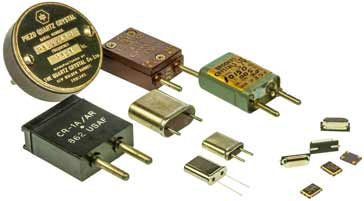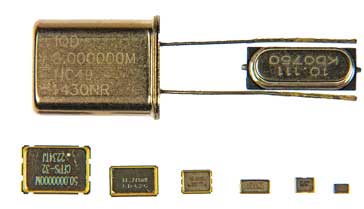How to Specify a Quartz Crystal Resonator
Quartz crystals require a number of specifications that are not normally needed for other electronic components.
Home » Electronic components » this page
Quartz Crystals, Xtals Tutorial Includes:
Quartz crystals: xtals
What is quartz
How a crystal works
Crystal overtone operation
Quartz crystal frequency pulling
Quartz crystal cuts
Quartz ageing
Crystal resonator manufacture
How to specify a quartz crystal
VCXO
TCXO
OCXO
Crystal filter
Monolithic crystal filter
Ceramic resonator & filter
Ceramic filter specifications
When looking at how to specify a quartz crystal resonator, it is necessary to understand what the manufacturers need in order to be able to make a component that fulfils the requirements placed upon it.
Specifications including load capacitance, resonance type, and many more are needed to be able to correctly specify a quartz crystal.

Often manufacturers will have a pro-forma sheet into which the various specification figures need to be added.
Frequency specification
Obviously the major specification for any quartz crystal resonator is its frequency. This is normally expressed to as many significant figures as demanded by the frequency tolerance, although seven figures is normally the maximum. It is wise to express the frequency to the right number of significant figures to avoid misunderstandings in this area of the quartz crystal specification.
Resonance type
There are two types of resonance that are applicable to quartz crystals. One is parallel resonance and the other is series resonance. The actual type required will depend on the circuit in use. Although crystals will operate in either mode, the frequency of resonance for each type of resonance is slightly different. For some applications such as microprocessor clock generators the small difference between the two frequencies may not be a problem, but for many others it is. Accordingly the crystal specification should clearly include the type of resonance required.
Crystal resonator mode
Quartz crystals may either operate in a fundamental mode or in an overtone mode. Below frequencies of around 25 MHz crystals are normally designed to operate in their fundamental mode, whereas above this they will normally be designed for overtone operation, although with manufacturing techniques improving higher frequency crystals are becoming available. The mode is therefore an important element of the crystal specification.
When ordering an overtone crystal quote the exact frequency of operation and not what is expected to be the fundamental frequency as confusion may arise over the frequency required, and as the overtone frequency of the crystal is not an exactly the same as the harmonic of the fundamental frequency this may result in an incorrect frequency being supplied. The frequency of overtone crystals is normally expressed in MHz, whereas one operating at its fundamental frequency is normally expressed in kHz.
Crystal load capacitance specification
The most common type of crystal is parallel resonant where the crystal operates at a frequency above its series resonant frequency (point of lowest impedance). When operated in a parallel resonant mode a crystal resonator needs a level of load capacitance. This is the capacitance of the oscillator circuit as presented to the quartz crystal resonator. The external capacitance forms part of the resonant circuit. One common value of load capacitance is 30pF, although 20pF is also widely used.Calibration tolerance specification
This is the final frequency of the crystal at manufacture at a temperature of 25°C which is normally assumed to the operating temperature of electronic equipment. However if the crystal is to be used in an oven then the temperature of the oven should be stated instead. The calibration tolerance itself is expressed in ppm (parts per million).
Temperature stability
The temperature stability is another important area of the crystal specification and it is the allowable frequency deviation as the temperature varies. Again normally expressed in ppm, from the frequency at the reference temperature per degree Celsius. Sometimes the crystal specification may use a frequency tolerance consisting of the sum of the calibration and temperature stability tolerances is quoted.
Package
Crystals come in a variety of packages. There are a number of standard varieties used with through-hole mounting and sockets. Styles such as HC43, etc are still widely available, but there are also many new packages for use with surface mount soldering. It is necessary to consult the manufacturers datasheets to make the final choice.

Quartz crystal ageing
Ageing of quartz crystals will depend upon a number of factors and in particular the encapsulation. It is generally greatest in the first few weeks of operation, and as a result crystals to be used in high quality oven oscillators are run in before use. Figures for ageing are expressed in a certain number of ppm over a given time, often a day and/or a year.
Spurious responses
In some applications the spurious responses may be of importance, but there are some responses that may be within a few hundred kilohertz of the main frequency. These are normally low, and rarely cause problems in oscillator circuits except if the tuned circuit used in the oscillator resonates on the same frequency as a nearby response. They may be more important in filter applications, and it may be necessary to specify maxim response levels relative to the main response. It is likely that in a filter several crystals will be used, and they will not all use the same frequency. This will result in the responses also appearing on different frequencies, making the problem less severe.
Activity
A measure of the activity of a crystal is the resistive component that is seen in the motional arm of its equivalent circuit. As would be expected the resistance and Q are inversely proportional to each other.
When placing an order for a quartz crystal it is necessary to ensure that everything is done to ensure that the specification is correct. It can sometimes take a few weeks to manufacture a prototype and therefore it is necessary to ensure everything is completed correctly to avoid misunderstandings and to ensure that all the data is correct. By specifying the crystal correctly, speedy service can normally be obtained.
 Written by Ian Poole .
Written by Ian Poole .
Experienced electronics engineer and author.
More Electronic Components:
Batteries
Capacitors
Connectors
ADC
DAC
Diodes
FET
Inductors
Memory types
Phototransistor
Quartz crystals
Relays
Resistors
RF connectors
Switches
Surface mount technology
Thyristor
Transformers
Transistor
Unijunction
Valves / Tubes
Return to Components menu . . .


